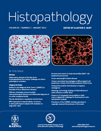Prevalence of the CTNNB1 mutation genotype in surgically resected fibromatosis of the breast
Abstract
Kim T, Jung E A, Song J Y, Roh J H, Choi J S, Kwon J E, Kang S Y, Cho E Y, Shin J H, Nam S-J, Yang J H & Choi Y-L (2012) Histopathology 60, 347–356 Prevalence of the CTNNB1 mutation genotype in surgically resected fibromatosis of the breast
Aims: To investigate CTNNB1 mutation and β-catenin expression in resected breast fibromatosis and to identify potential molecular markers of fibromatosis of the breast.
Methods and results: We selected 12 patients with fibromatosis of the breast who underwent surgical resection and were confirmed by histological examination. Ultrasonography findings for 10 patients were reviewed and only two cases were suspicious for fibromatosis on imaging. On core needle biopsy for pre-operative diagnoses, only three cases were histologically suspicious for fibromatosis. Mutations in exon 3 of CTNNB1 were detected by direct DNA sequencing in nine (75.0%) cases: all were c.121G>A (p.T41A), which was much more frequent in breast fibromatoses than in other soft tissue lesions. Nuclear β-catenin expression was observed in all cases and the level of expression was higher in cases with mutation. In eight of nine cases, the matched biopsy specimen showed the same CTNNB1 mutation status as the pre-operative specimen.
Conclusions: In the majority of cases, clinical presentation and breast imaging are highly suspicious for carcinoma. Definitive pre-operative pathological diagnosis by core needle biopsy is difficult. CTNNB1 mutation and nuclear β-catenin expression are frequently detected in sporadic breast fibromatoses, suggesting their potential as a useful tool to distinguish breast fibromatoses from other neoplasms.




